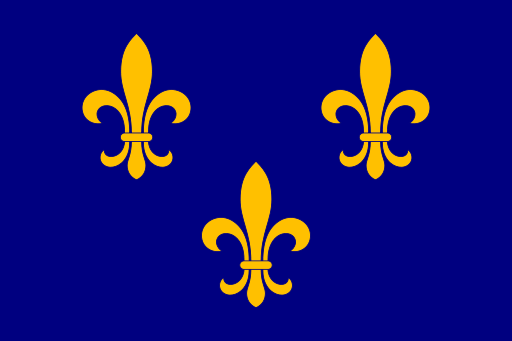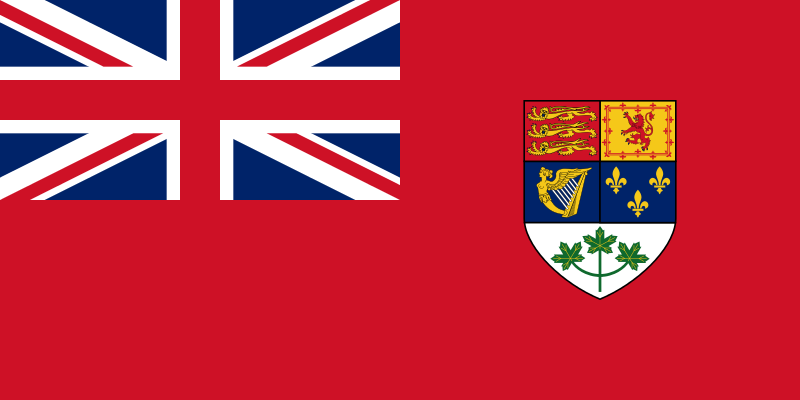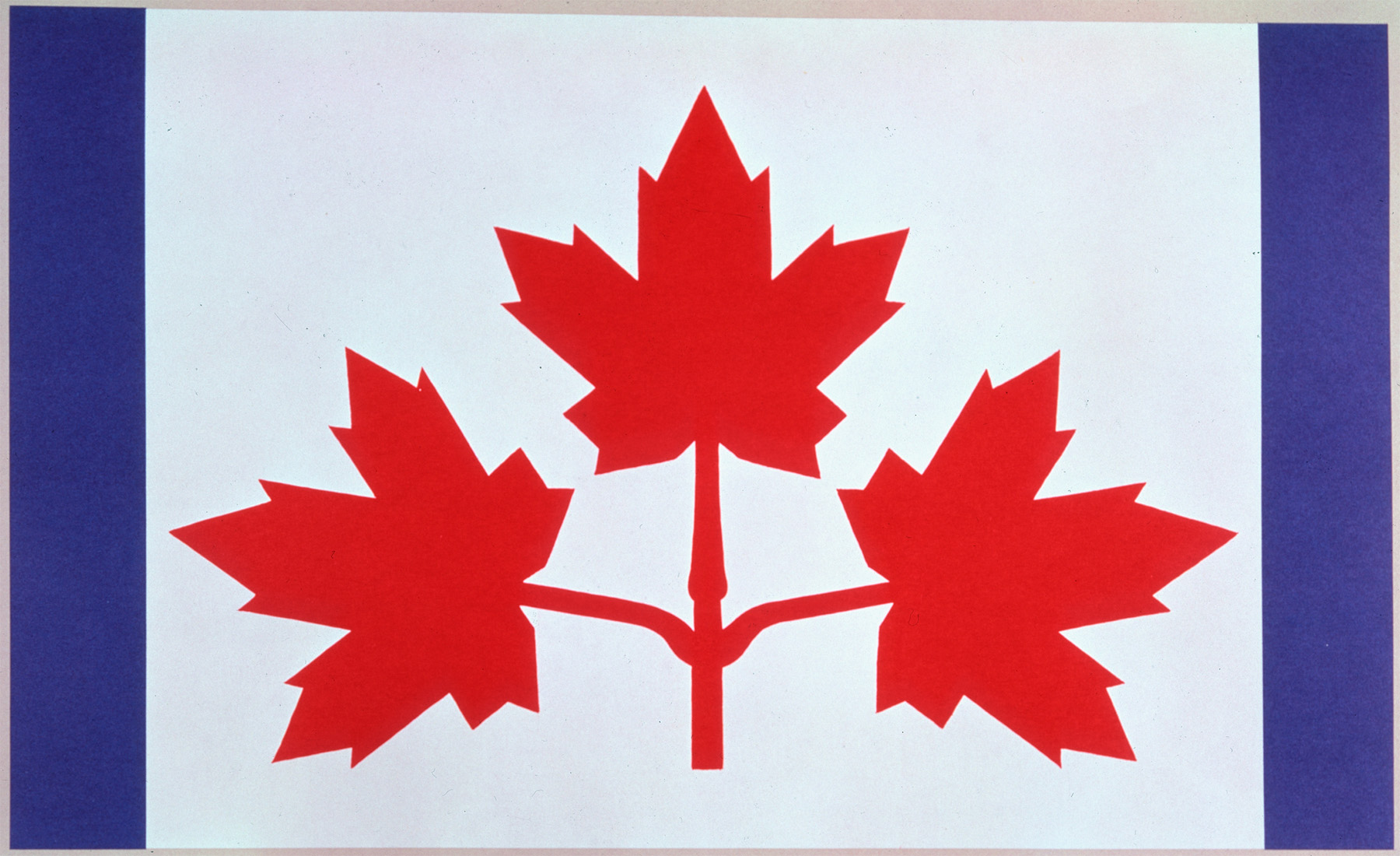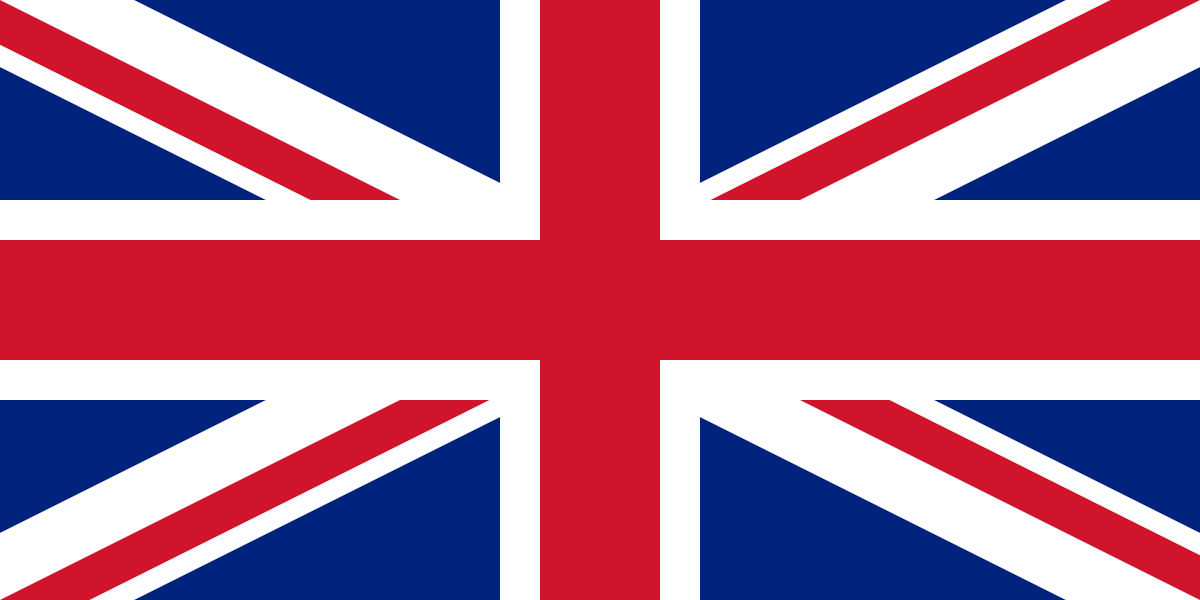The National Flag of Canada, also known as the Canadian Flag or the Maple Leaf Flag (l’Unifolié in French), consists of a red field with a white square at its centre in which sits a stylized, 11-point red maple leaf. A joint committee of the Senate and House of Commons voted for the present flag in 1964 against formidable odds. (See The Great Flag Debate.) After months of debate, the final design, adopted by Parliament and approved by royal proclamation, became Canada’s official national flag on 15 February 1965. In 1996, February 15 was declared an annual National Flag of Canada Day.

Background: The First National Flags
At the time of New France (1534 to the 1760s), two flags could be viewed as having national status. The first was the banner of France — a blue square flag bearing three gold fleurs-de-lys. It was flown above fortifications in the early years of the colony. For instance, it was flown above the lodgings of Pierre Du Gua de Monts at Île Sainte-Croix in 1604. There is some evidence that the banner also flew above Samuel de Champlain’s habitation in 1608. Afterwards, the completely white flag of the French Royal Navy was flown from ships, forts and sometimes at land-claiming ceremonies. Early in the 17th century, it was regarded by the inhabitants of the colony as the emblem of the French nation and therefore as their own national flag.
The Red Ensign, flag of the British Merchant Marine, was flown from the forts and canoes of fur companies. The letters “HBC” were added by the Hudson’s Bay Company and “N.W.Co.” by the North West Company. The Royal Union Flag (also known as the Union Jack) was also flown at times from company forts. (See also: Trading Post.) After 1759, these same two flags appeared on military forts.

Around 1870, Canada began flying the Red Ensign as its flag. It included the coats of arms of the four original provinces of Confederation on one shield. The royal crown was usually featured on top of the shield, a beaver below and branches of maple on both sides. (As new provinces joined Confederation, their arms were added to the shield. This made the flag hard to distinguish, particularly at sea.) In 1892, a warrant of the British Admiralty authorized merchant vessels registered in Canada to fly the Red Ensign with only the four original provinces represented in the shield. During this period, the Union Flag was also flown on land, particularly after 1904, when it replaced the Canadian Red Ensign atop the Peace Tower on Parliament Hill.
In 1945, the Red Ensign with the shield of arms granted to Canada in 1921 was authorized to fly on federal buildings in Canada and abroad until Canada adopted an official national flag.

Adopting a National Flag
The first government attempt to give Canada a flag came in 1925. Prime Minister William Lyon Mackenzie King set up a committee to study the question. He immediately backed down when there was a general outcry against any attack on the Union Jack. He tried again in 1945 with a joint committee of the Senate and House of Commons. But support for the Union Jack remained strong, particularly within the Orange Order. When the committee presented its report, King again abandoned the idea for lack of consensus. The public submitted 2,409 designs to the national flag committee. Maple leaves were featured in 1,611, Royal Union Flags in 383, stars in 231, fleurs-de-lys in 184, beavers in 116, crowns in 49, and crosses in 22.
An important specialist to appear before the 1945 committee was A. Fortescue Duguid. He was director of the Historical Section of the Canadian Army. He pointed out that red and white were Canada’s national colours as found in the coat of arms of Canada granted by King George V in 1921. He also asserted that Canada had its own emblem: three maple leaves joined at one stem on a white field, as found in the base of Canada’s Shield.
The Great Flag Debate
Lester B. Pearson, as leader of the Official Opposition, raised the flag question again in 1960. At the time, national unity was threatened by a growing separatist movement in Quebec. Many Canadians had become attached to the Canadian Red Ensign, which they believed to be their national flag. Others still clung to the Union Jack. Since 1948, Quebec viewed its provincial flag, the Fleurdelisé, as its national emblem.
In 1964, artist and heraldic advisor Alan B. Beddoe presented Pearson with a flag design. It depicted a sprig of three red maple leaves on white flanked by two vertical blue bars. The simple message “Canada from sea to sea” seemed to please Pearson. He introduced the design to Parliament in June 1964.
All parties agreed that Canada should have a flag, but there was no agreement on its design. Feelings ran high among many English-speaking Canadians. French Canadians followed the debate with keen interest. John Diefenbaker demanded that the flag honour the “founding races,” and display the Union Jack. Pearson insisted on a design that was free of colonial association and represented allegiance to Canada. Pearson’s choice, dubbed the “Pearson Pennant,” was derided by journalists and editorial cartoonists. It was generally viewed as a concession to Quebec.
When Pearson saw that it could not be adopted in Parliament, he appointed an all-party committee in September 1964. Seven Liberals, five Conservatives, one New Democrat, one Social Crediter and one Créditiste were appointed. They were given six weeks to decide on a final design. John Diefenbaker was elated with this outcome. He was convinced that the complicated formula spelt the death of Pearson’s flag. He was prepared to accept the committee’s decision only if the vote resulted in a clear majority — 13 out of 15, for instance.

Herman Batten, MP from Newfoundland, acted as chairman. John Matheson, MP from Ontario, played an active role as Pearson’s right-hand man within the committee. Duguid again testified at length, presenting essentially the same views he expressed in 1945. His insistence on three leaves was viewed by some as a message of division. The views of the historians brought before the committee, Arthur Lower and Marcel Trudel, were in stark contrast. Lower stressed the need for a new distinctly Canadian emblem. His preferred candidate was the maple leaf. Trudel thought the flag should contain the symbols of the founding nations, something which had been done in the 1921 arms of Canada. He did not think the maple leaf was a significant symbol, a position akin to that of Diefenbaker. Another witness before the committee was Group of Seven painter A. Y. Jackson, who submitted designs of his own.
Over the course of six weeks, the committee held 35 meetings and pored over thousands of suggestions submitted by the public. According to Library and Archives Canada, some 2,000 suggestions were submitted in 1964 and examined by a steering committee, in addition to 3,900 others, “including those that had accumulated in the Department of the Secretary of State and those from a parliamentary flag committee of 1945–1946.”
Three flags remained after a process of elimination: the Pearson Pennant, the present flag with a differently styled leaf, and the same flag with the Union Jack on the upper left red band and the banner of France on the other. The final vote was between the Pearson Pennant, designed by Alan Beddoe, and the single leaf flag, designed mostly by George Stanley and inspired by the flag of the Royal Military College of Canada.
When the time to vote came on 22 October 1964, the Conservatives believed that the Liberals on the committee would surely vote for the Pearson Pennant. So they voted for the single-leaf design instead. However, Liberal committee members voted against the Prime Minister’s preferred design. The result was unanimous: a vote of 14–0 for the single-leaf design (the chairman of the committee abstained from voting).
The ensuing debate in the House lasted another six weeks and involved 308 speeches. (See also: The Great Flag Debate.) Léon Balcer, a prominent Conservative MP from Quebec, invited the Liberals to invoke closure. This limited speeches to 20 minutes and forced a vote. On 15 December 1964 at 2:00 a.m., the committee’s recommendation was accepted by a vote of 163 to 78. Senate approval followed on 17 December. The royal proclamation was signed by Queen Elizabeth II on 28 January 1965. The Canadian Red Ensign was taken down, and the national flag officially unfurled on 15 February 1965 at Parliament Hill.
Design
The major player in the design of Canada’s flag was George Stanley, dean of arts at the Royal Military College of Canada. His letter to Matheson on 23 March 1964 contains two drawings. One is divided vertically, with red, white and red in equal parts and a red maple leaf in centre. Another is divided horizontally in the same colours and proportions with three maple leaves on one stem. Like Duguid, Stanley stressed that red and white were the colours of Canada. He preferred one well-stylized maple leaf, as it communicated unity and could be immediately recognized as Canadian. He also advocated for simplicity and traditional symbols. Emblems from other countries such as the Union Flag or the fleur-de-lys were not favoured. He rejected the Canadian Red Ensign as being too complicated and hard to identify. In his letter to Matheson, Stanley had traced a route leading to a national flag. However, getting his vision accepted would require a long intellectual and political journey.
Matheson did not reject Stanley’s proposal, although he felt that something was missing. A design submitted by George Bist, a war veteran, was close to Beddoe’s conception, but with a single maple leaf in the centre on a square, which made room to enlarge the leaf. Matheson combined Stanley’s design with Bist’s square and introduced it quietly among the designs.

The flags submitted to the committee totalled some 5,900. As in 1945–46, they tended to be repetitive. There were many beavers, maple leaves, Union Jacks, fleurs-de-lys, lions, stars, the polar star, religious symbols, various crosses, and stripes. A. J. Casson of the Group of Seven submitted a blue flag with three red maple leaves edged in white. However, none of the designs seemed to command the respect expected of a national flag.
The Flag of Canada is unique in that it displays a white square in its centre. This could not be described in the heraldic language of the time. Fortunately, Conrad Swan, a Canadian officer of arms at the College of Arms in England, proposed to call the square a “Canadian pale” because it is twice as wide as an ordinary pale (a vertical band occupying one third of the shield’s surface). This expression is now accepted as part of heraldic vocabulary. (See Heraldry.) Another unique feature is the stylized maple leaf, which required painstaking work.
The original leaf as depicted by Alan Beddoe, artist for the committee, had 13 points. Matheson studied the behaviour of a model of the sugar maple leaf when flapping in the wind tunnel of the National Research Council’s laboratory. He finally opted for 11 points and supervised the stylization of the leaf. It was done by the graphic artist Jacques Saint-Cyr of the Canadian Government Exhibition Commission. Everything became so precise that, when the proportions and stylization of the leaf are not respected, the flag loses much of its beauty and impact. (According to the Government of Canada, the decision to use a leaf with 11 points was made to "to help keep the symbol visible and distinct when seen from far away and in windy conditions." The 11 points "do not reflect [the number of] Canada's provinces and territories.")
Joan O’Malley acted as seamstress to create a prototype in cloth to present to the Prime Minister. Yvonne Diceman, artist and calligrapher, prepared the actual royal proclamation on a piece of vellum (calf skin) provided by Beddoe.
Since the early years of the 19th century, the maple leaf had been recognized as a Canadian emblem by anglophones and francophones alike. It was celebrated in poetry, song, coinage, medals and flags, as well as in popular imagery such as postcards. With the flag, the maple leaf became the emblem of all Canadians. No doubt it also helped strengthen the fleur-de-lys as the national emblem of francophones in Quebec and elsewhere. (See also: Franco-Ontarian Flag.)
National Flag of Canada Day
National Flag of Canada Day was instituted in 1996. The chosen date was 15 February, in commemoration of the day the flag was unfurled on Parliament Hill. The event is observed nation-wide in various ways, although it is not a national statutory holiday.
(See also: Editorial: Editorial: The Canadian Flag, Distinctively Our Own; Editorial: The Stanley Flag and the “Distinctive Canadian Symbol”; Flag of Canada: Alternate Designs; The Great Flag Debate.)

 Share on Facebook
Share on Facebook Share on X
Share on X Share by Email
Share by Email Share on Google Classroom
Share on Google Classroom










